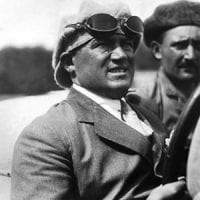One of the great names of 1920s motor racing, Antonio Ascari had a tragically short career. He was the son of a Lombardy corn dealer and the Ascari family moved to Milan at the turn of the century. Ascari then served as an apprentice mechanic before opening his own car workshop.
Alfa Romeo star
He started racing in 1911 and began to be serious when he acquired a five-year-old Fiat S74 in 1919. Victory in the Parma-Berceto and Consuma hillclimbs was balanced by crashing into a ravine after just 30 miles of that year’s Targa Florio.
He joined Alfa Romeo in 1920 and came to the fore three years later when driving its RL models. He only lost the 1923 Targa Florio to team-mate Ugo Sivocci when delayed by a crash at half-distance but Ascari won at Cremona and was third at Mugello. He was due to race a P1 in the Italian Grand Prix but the team withdrew after Sivocci was killed in practice.
Grand Prix pacesetter
Another Cremona success in 1924 was achieved in the sensational new Alfa Romeo P2 but Ascari endured frustration in that year’s Targa Florio and French GP – losing victory with engine problems within sight of the finish. However, his maiden GP success came at Monza that autumn after leading all the way.
His status as the sport’s pacesetter at the start of 1925 was confirmed by victory in the inaugural Belgian GP and he was clear favourite for the all-important French GP at Montlhéry.
The Italian duly led at the start and set a furious pace – leading at quarter distance by almost four minutes. Light rain began to fall and whether this contributed to his accident is unclear. Ascari’s inside front wheel caught the fencing that lined the track on the fast left-hander before re-entering the banked section and sent the Alfa into a roll. Ascari was thrown out and suffered injuries from which he died before reaching hospital.
Antonio Ascari left a wife, daughter and seven-year-old son. That boy would scale even greater heights but like his father would die in his prime. Tragic symmetry mapped their lives.


